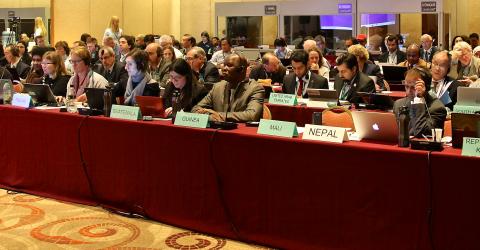
How the Standing Committee works
The Standing Committee has clearly defined tasks and procedures. Its tasks were first set out in 1993 in the Framework for Implementation of the Convention on Wetlands (Resolution 5.1), but are currently defined by Resolution VII.1 (1999). Its composition and responsibilities were amended by Resolution XIV.2 (2022).
Membership is determined using a proportional system. Each regional group is represented according to the number of Contracting Parties in the group. The hosts of the previous and next COPs are also represented.
The roles of members
Contracting Parties elected as Regional Representatives on the Standing Committee have the following tasks:
- To designate delegates to the Standing Committee, and make every effort to ensure that delegates or their substitutes attend meetings.
- To consult regularly with other representatives of their regional group.
- To maintain regular contact with all the Contracting Parties in their regional group, and canvass their opinions before meetings of the Standing Committee.
- To advise the Secretariat in setting the agendas of Regional pre-COP meetings.
- Where possible, to attend other regional and international meetings to consult about issues related to the Convention and promote its objectives.
- To serve as members of Standing Committee subgroups.
- To advise the chairs of the Standing Committee and its subgroups and the Secretariat as requested.
- To encourage other countries in their region to join the Convention.
Subgroups
The Standing Committee allocates specific tasks to members working in subgroups, including the Management Working Group (with a role defined by Resolution IX.24 and Decision SC34-3) and the groups covering finance (Decision SC16-1) and the planning of the next COP meeting (Decision SC34-6). Oversight panels review the progress of the CEPA Programme and the STRP.
Procedural rules
Rules of Procedure for meetings of the Standing Committee, in all matters not specified in Resolution VII.1, are governed by the Rules of Procedure for the Conference of the Contracting Parties.
Interpreting between English, French and Spanish is provided for plenary sessions of the meetings but not for subgroup meetings. In 2014, the Standing Committee decided that meeting documents should be available in French and Spanish as well as English.